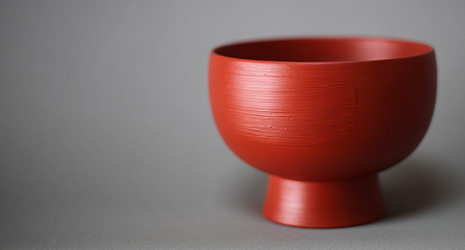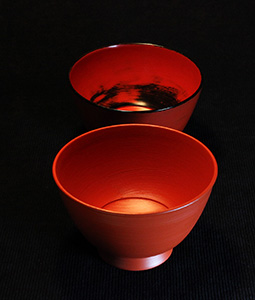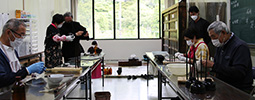May 2022
- English
- 日本語
Reviving the Production of “Negoro” Vermilion Lacquerware

A Negoro-nuri lacquerware bowl 
Ikenoue painting vermilion lacquer at the workshop

Negoro-nuri master craftsman Ikenoue Shinzan 
With use, the black lacquer has become visible, creating new patterns 
A community class led by Ikenoue

The vermillion lacquerware called “Negoro-nuri” has a long history dating back to the medieval period, but production of it ceased for some time before recently being revived. Negoro-nuri is said to become more attractive with use, a characteristic which owes to its complex and laborious production process.

Negoro-nuri (also known as “Negoro”) had been produced since the medieval period in Iwade City, Wakayama Prefecture, on the Kii Peninsula slightly west of central Honshu. It was used for a variety of everyday utensils thanks to its durability and high quality. The lacquerware is attractive for two more reasons as well. One is that its luster grows over time. The other is that the vermilion lacquer on its surface wears away with use over many years to reveal patterns of black lacquer undercoat (shitaji), adding attractive color tones to the lacquerware.
Negoro-nuri is said to have been produced by specialist lacquerware craftsmen in a workshop at Ichijozan Daidenpoin Negoro-ji Buddhist Temple (Negoro area, Iwade City, Wakayama Prefecture) from the Kamakura to Muromachi periods (late twelfth century to late sixteenth century). The Negoro lacquerware produced was mainly everyday utensils such as rice and soup bowls, and tools, and was used by shrines and temples as well as by members of the upper class. It has a complex production process of twenty-six steps. Multiple lacquer undercoats are applied to the wooden base, after which hemp cloth is affixed to the edges, rim, and other easily chipped parts of the vessel. More layers of lacquer are then applied, and a soft wooden spatula is used to smooth it into a uniform shape. The vessel then undergoes processes such as sabi-tsuke* and polishing to produce the finished undercoat. Next, a primer coat of black lacquer is applied and left to dry, after which the surface of the vessel is repeatedly polished and lacquered. A final top coat of vermilion lacquer is applied to complete the Negoro-nuri process. It takes more than three months to produce the undercoat lacquer layer, compared with around one month for ordinary lacquerware. As a result, the thickness of the undercoat is said to be two to three times that of ordinary lacquerware.

It is this complex and laborious process that produces Negoro-nuri’s defining characteristic of durability. Normally, freshly boiled water can damage lacquerware. However, Negoro-nuri is able to withstand boiling water, dropping, and even being washed and dried by a dishwasher.
“Negoro-nuri originated during a turbulent period of civil war, so it needed to be easy to use, portable, and unbreakable. That’s why Negoro-nuri employs a unique technique that produces a toughness not found in ordinary lacquerware.”

So says Negoro-nuri craftsman Ikenoue Shinzan. Ikenoue was apprenticed to the late Kawada Sadamu, a leading researcher on Negoro-nuri lacquerware. In 2000, more than 400 years after production of Negoro-nuri ceased, Ikenoue revived the original technique at Negoro-ji Temple, where it had originated in the medieval period.
The coloring pigment used for vermilion lacquering is cinnabar, which is a natural mineral. Cinnabar was said to be as precious as gold in medieval times, which tells us that Negoro-nuri was made mainly for the upper classes. The vivid crimson color produced by cinnabar has appealed to people through the ages.

Says Ikenoue, “Negoro-nuri is not only durable, it’s also easy to use and has a simple beauty of form that one never tires of. The vivid vermilion color of a new piece is stunning, but its luster becomes even more pronounced with use. Even scratches and signs of aging look like a beautiful pattern. And even if the surface peels off after years of use, there’s no need to apply a new coat of lacquer as you would with ordinary lacquerware. The passage of time may itself be said to create beauty.”
In December 2019, Ikenoue received the Japanese Government’s Commissioner for Cultural Affairs Award. He has also begun to train others in the Negoro-nuri craft, holding classes for professionals and running community classes for the public to make plates, bowls, and chopsticks in order to pass on the authentic medieval techniques he has revived.
* Sabi (rust) is made by mixing powdered whetstone containing water with raw lacquer and allowing it to rest for at least one day. It is then mixed with raw lacquer and applied to the wood with a spatula.

